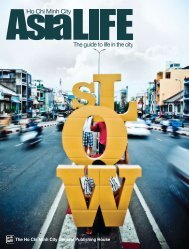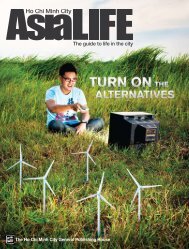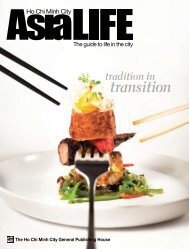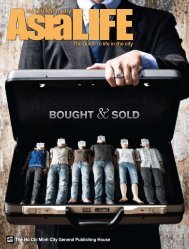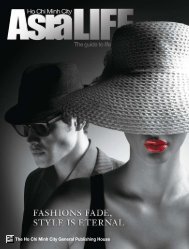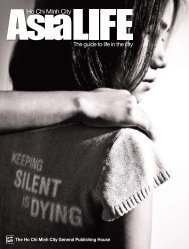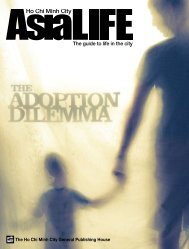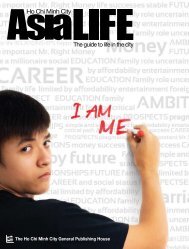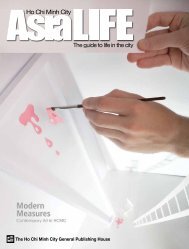issue 54 - AsiaLIFE Magazine
issue 54 - AsiaLIFE Magazine
issue 54 - AsiaLIFE Magazine
Create successful ePaper yourself
Turn your PDF publications into a flip-book with our unique Google optimized e-Paper software.
Carl Robinson<br />
The American-turned-Australian was a correspondent for The Associated<br />
Press’s Saigon bureau from 1968 to 1975, and now returns to the country<br />
regularly with his Vietnamese wife. Photo by Fred Wissink.<br />
What was it like being here<br />
in the 70s?<br />
My perspective was always<br />
different from other correspondents,<br />
more politics-oriented,<br />
because prior to that I had<br />
worked with USAID and because<br />
I knew the Vietnamese. I<br />
didn’t cover much shoot-em-up,<br />
bang-bang stuff. I learned early<br />
on, you can get killed doing<br />
that. I lost a lot of colleagues<br />
who went out on the frontlines.<br />
I covered opposition politics.<br />
I also did a lot of social sorts<br />
of stories, Tet stories, refugee<br />
stories.<br />
Did you have any close calls?<br />
The hairiest operation I was involved<br />
in was the Laos invasion<br />
in 1971, being under artillery<br />
fire, being ambushed out on the<br />
road. But I never pretended to<br />
be a combat reporter. I was a<br />
correspondent and there was a<br />
war going on.<br />
What about the day-to-day?<br />
I’d get up, have breakfast, get<br />
on my motorbike, and get to the<br />
office by 7.30 or 8am. I’d catch<br />
up with what happened overnight,<br />
ongoing developments.<br />
As photo editor, you were making<br />
sure your photographers<br />
can ship down to you from<br />
where they are. In the afternoon,<br />
photos would be coming<br />
down and reporters would<br />
be calling in. We also covered<br />
Cambodia, so we’d meet the<br />
plane, get the photos. It took 20<br />
minutes for each photo to be<br />
sent through shortwave radio<br />
through Tokyo. And Vietnam<br />
could intercept them, and they<br />
did sometimes, using them for<br />
their own propaganda. NBC<br />
was next to us, they had to ship<br />
their film out every time. We<br />
didn’t realise the impact our<br />
photos were having, but we<br />
wanted to know who had won<br />
the competition for play that<br />
day. Some we knew, the photo<br />
of the Viet Cong execution<br />
or the napalm girl, we knew<br />
something like that would be<br />
dynamite.<br />
Tell me about your colleagues.<br />
There were 100 or so in the<br />
press corps. There was a line<br />
between the boozers and<br />
the heads (drug users). You<br />
socialise with each other. I was<br />
a head. This street was full of<br />
girly bars (pointing to Dong<br />
Khoi). There were only French<br />
restaurants, so it’s nice to see<br />
that’s changed. There were not<br />
a lot of Vietnamese restaurants<br />
then, so a lot of correspondents’<br />
first encounter with Vietnamese<br />
food was [my wife] Kim’s<br />
cooking. Remember, there was<br />
a midnight curfew. The streets<br />
were deserted. You could get<br />
a pass but it was better not<br />
to push your luck because<br />
they had militias out, military<br />
patrols. If you invited people<br />
over for dinner, it became a<br />
sleepover.<br />
What stories were you<br />
most proud of?<br />
I was one of the journalists who<br />
broke the tiger cage stories on<br />
Con Dao island. There were<br />
heart-wrenching stories about<br />
political prisoners. I was quite<br />
pleased with my coverage of<br />
the Laos invasion; got photos<br />
of people hanging onto a<br />
helicopter.<br />
What’s it like returning<br />
to Vietnam?<br />
It’s really exciting getting to<br />
know Vietnam. One thing that’s<br />
helpful in me getting over<br />
Vietnam is becoming very interested<br />
and knowledgeable about<br />
Vietnamese history. We were<br />
just a part of Vietnam’s long<br />
sweep of history. We weren’t the<br />
first, don’t feel bad.<br />
What are these tours<br />
you organise?<br />
We bring Australian veterans<br />
and Viet Kieu back here. It’s important<br />
to come back here and<br />
see Vietnam again, especially<br />
vets, they have a lot of baggage.<br />
They bring their wives along,<br />
and by the end, [the wives]<br />
understand where it all comes<br />
from. It’s a life-changing experience.<br />
The Vietnamese haven’t<br />
been wallowing. They’re a good<br />
example for the veterans. I think<br />
seeing them and the attitude<br />
of the Vietnamese is good for<br />
them. It’s been the most heartening<br />
thing we’ve done, getting<br />
them together with old enemies.<br />
By the end, they’re all drunk<br />
and hugging and they get it.<br />
The best thing you can do is go<br />
back to a traumatic place and<br />
get over it.<br />
How do you think people here<br />
deal with the history?<br />
Vietnamese are very pragmatic.<br />
They don’t have time to sit<br />
around and be bitter. We think<br />
there must be guilt, ingrained<br />
guilt, you feel bad if you do<br />
something bad. Here, the bad is<br />
accepted; the good and the bad,<br />
the yin and yang. Buddhism<br />
is part of it, life is suffering.<br />
Whereas in the west, we’re<br />
always looking for solutions,<br />
we strive for happiness and we<br />
don’t know how fleeting happiness<br />
is.<br />
18 asialife HCMC



